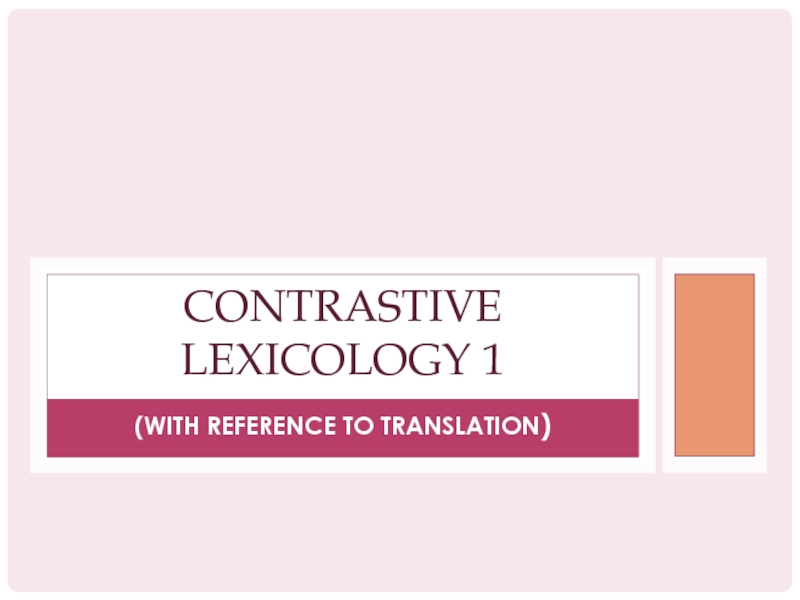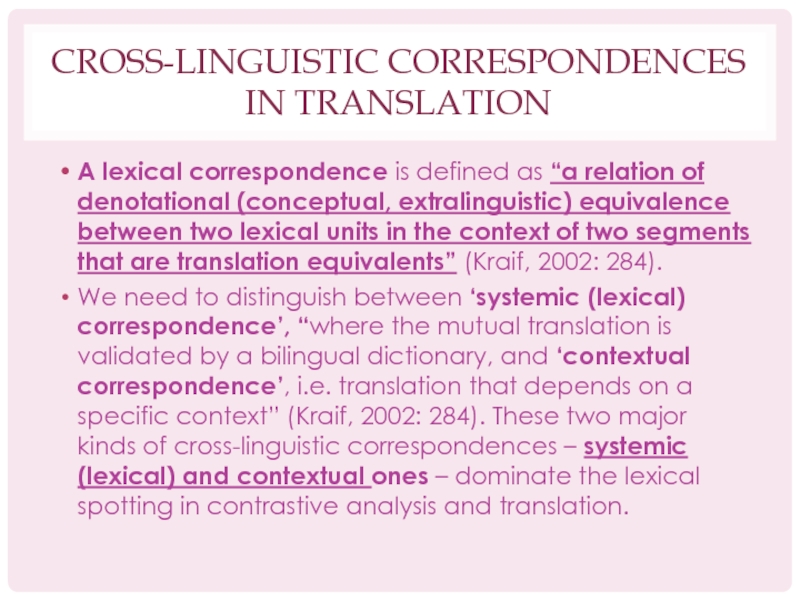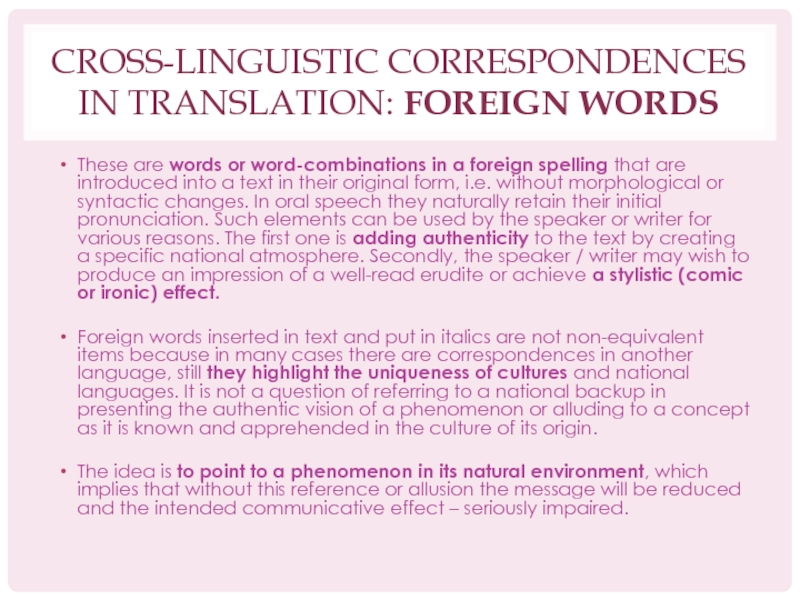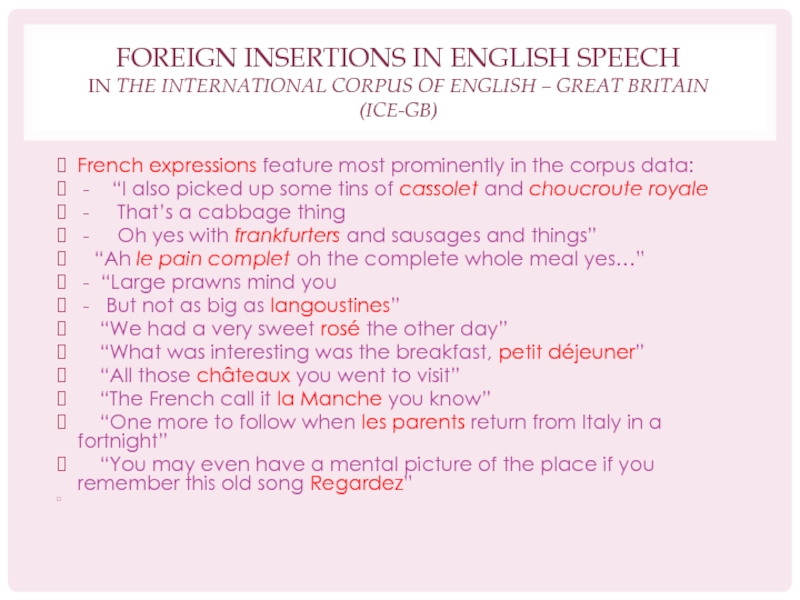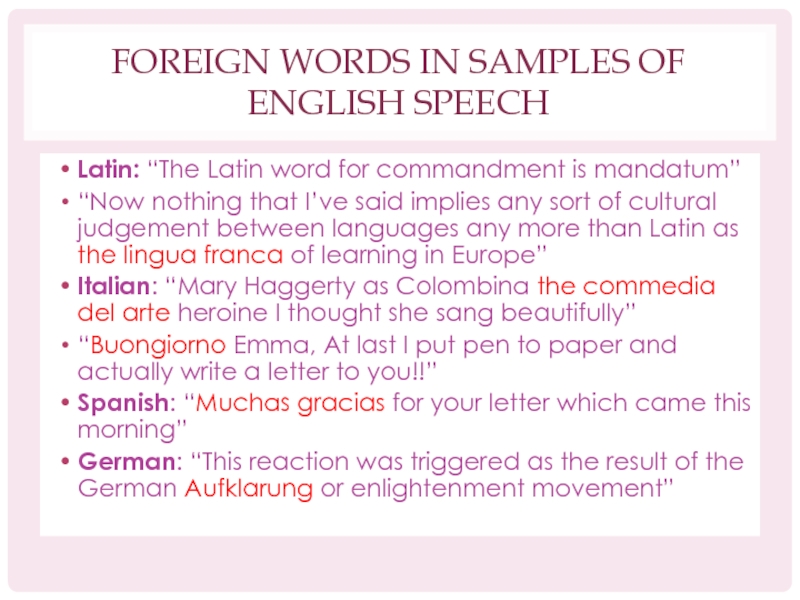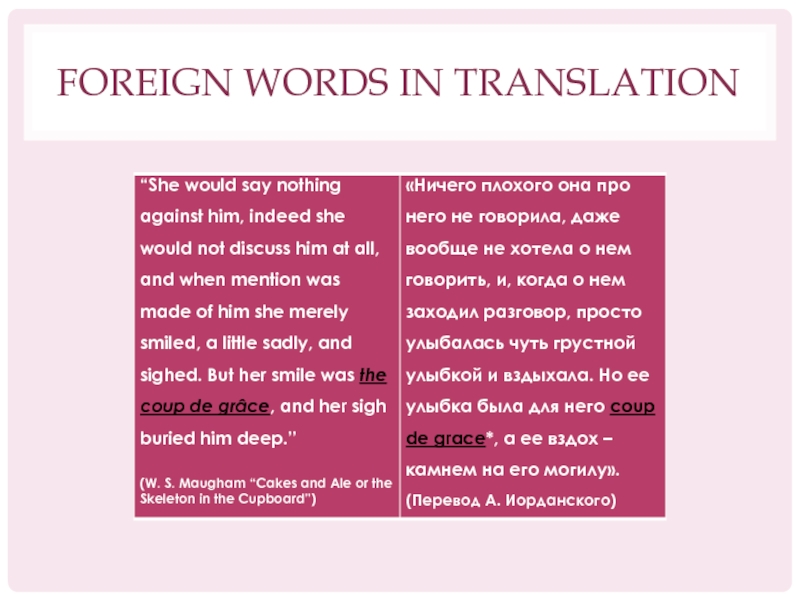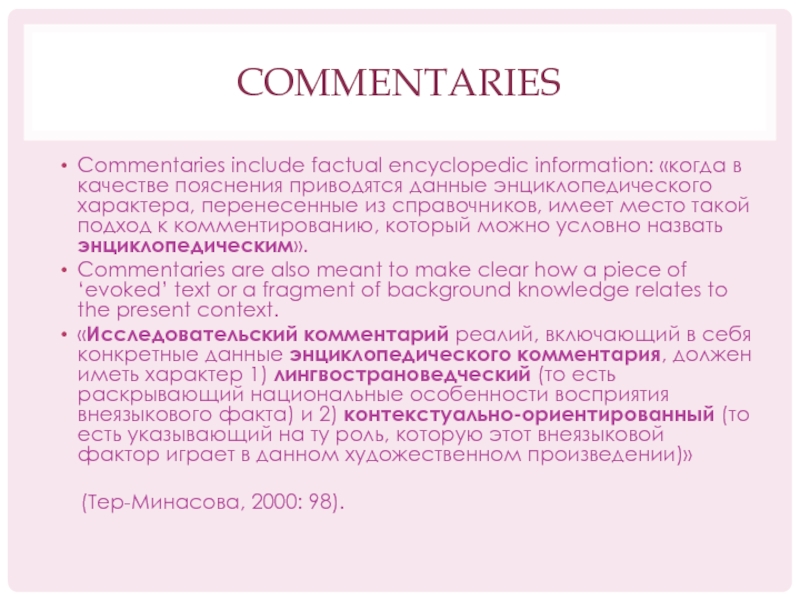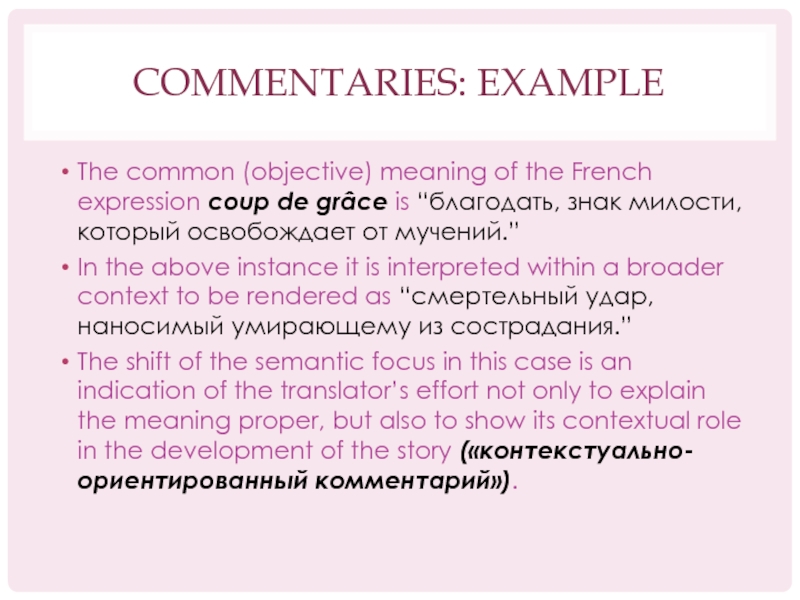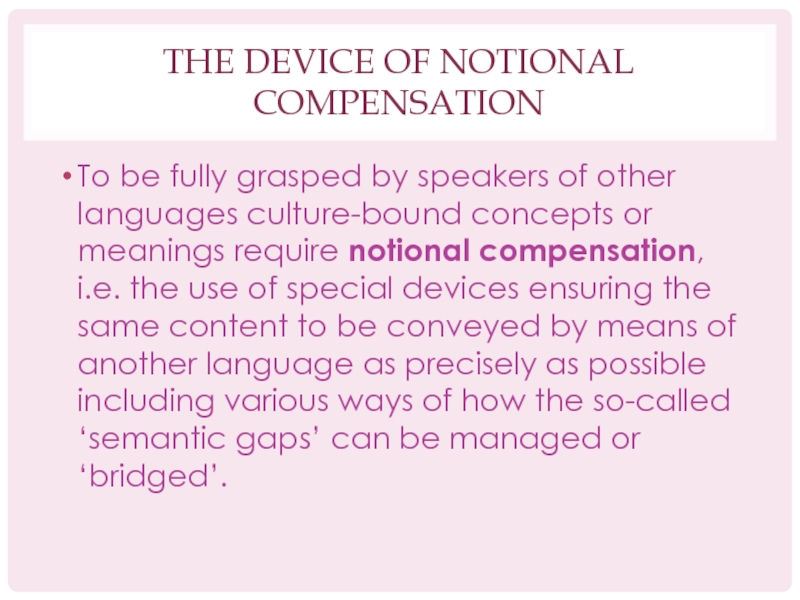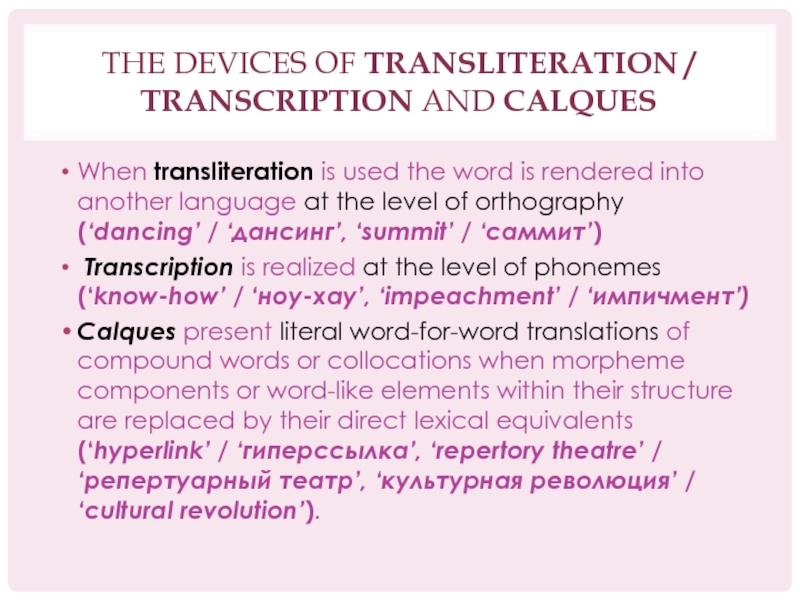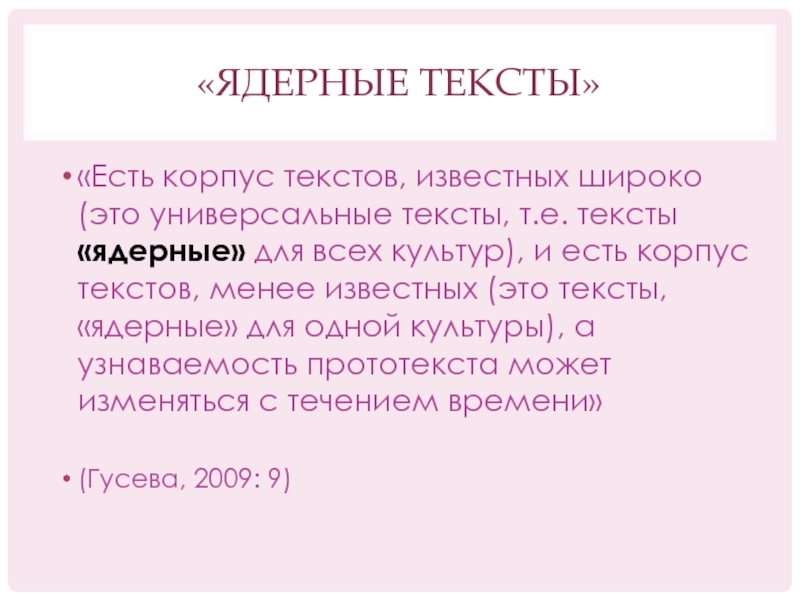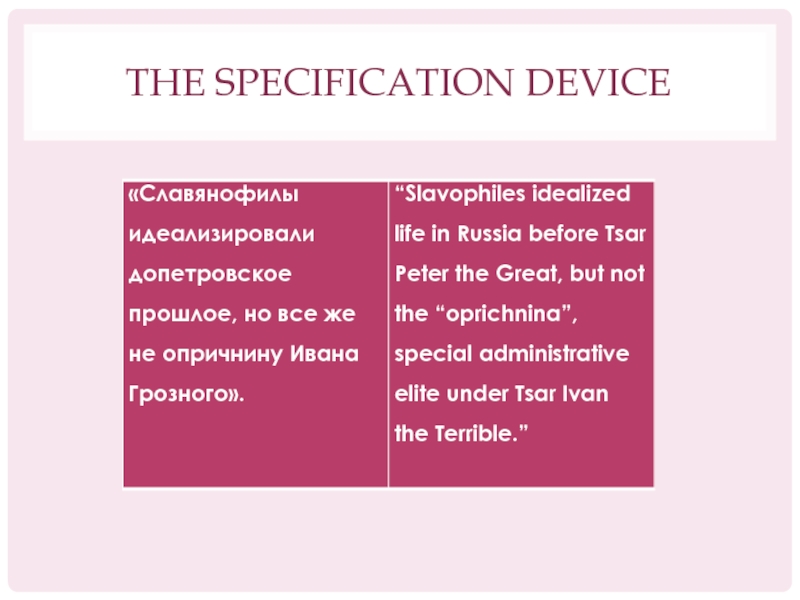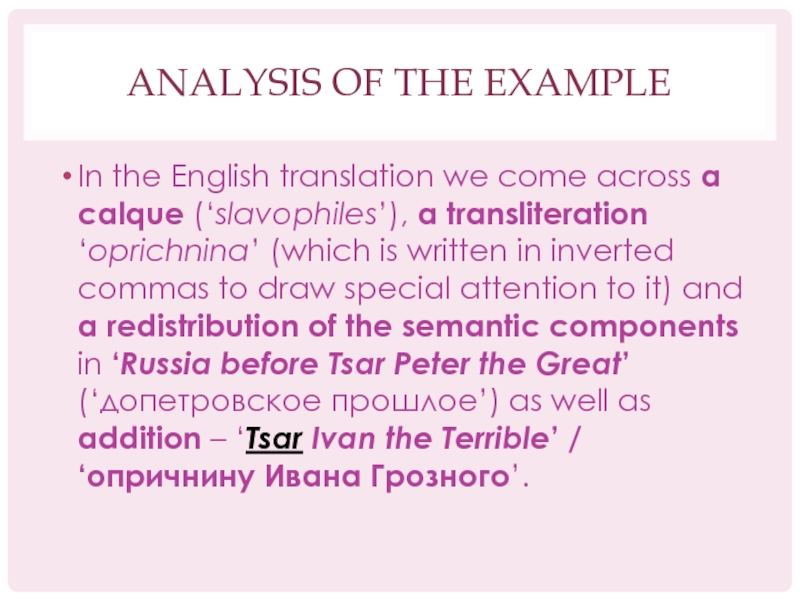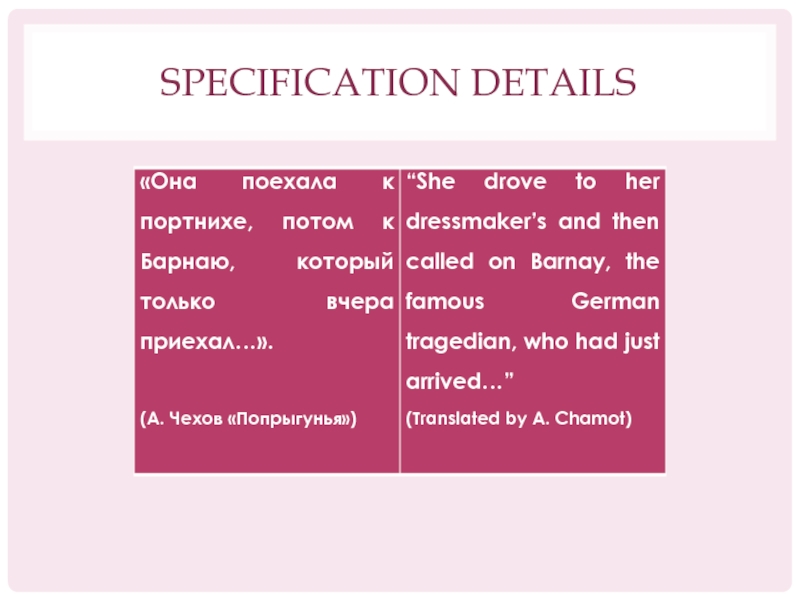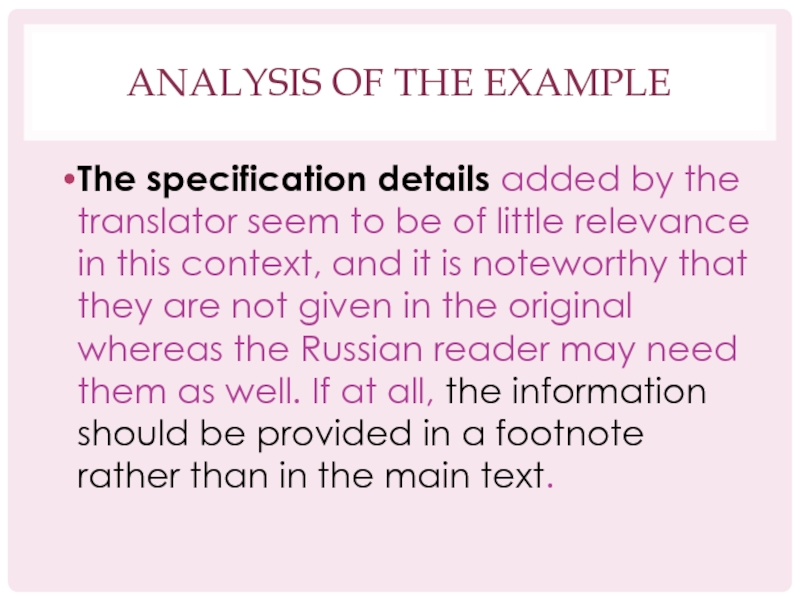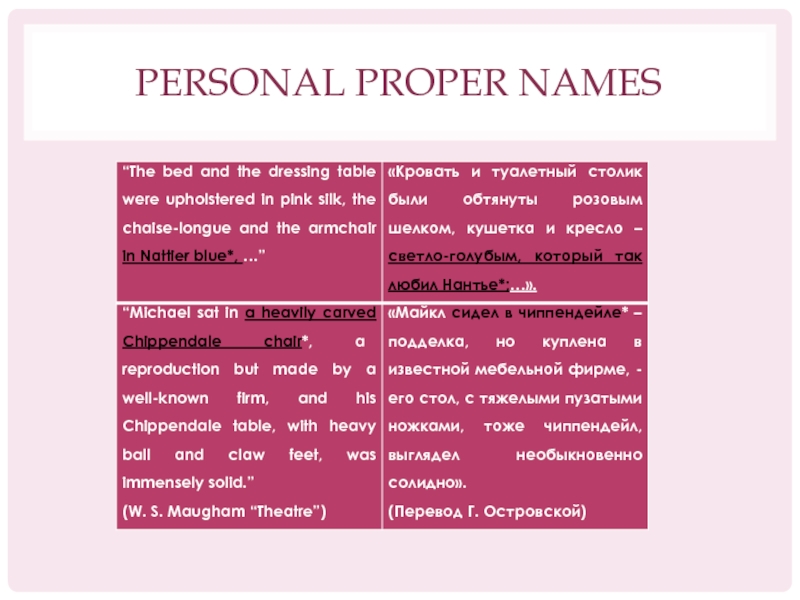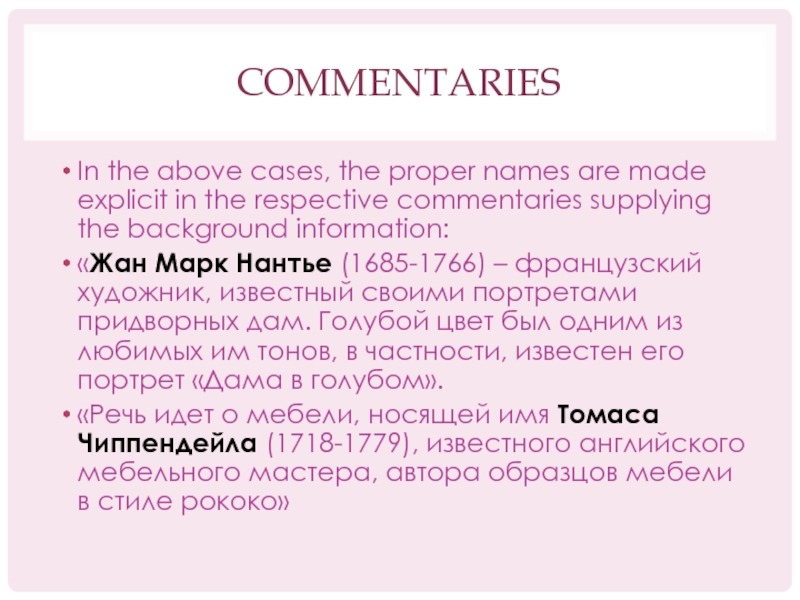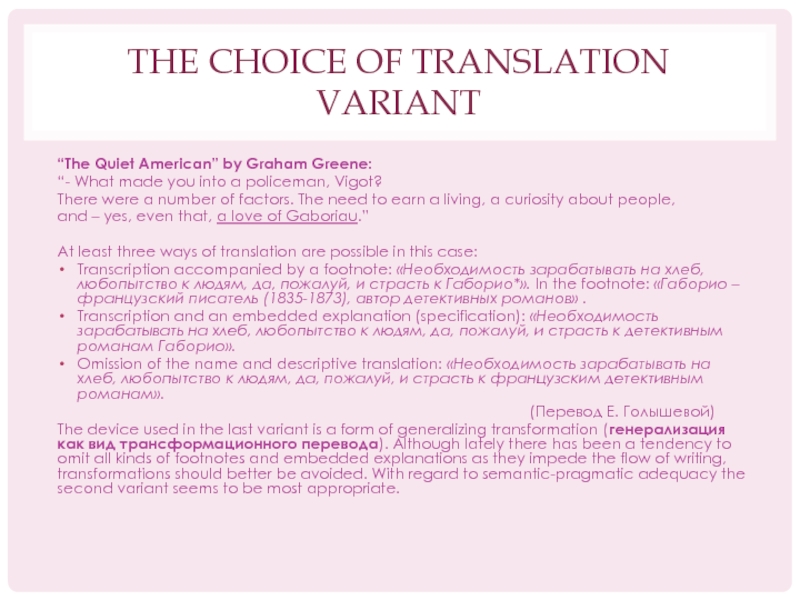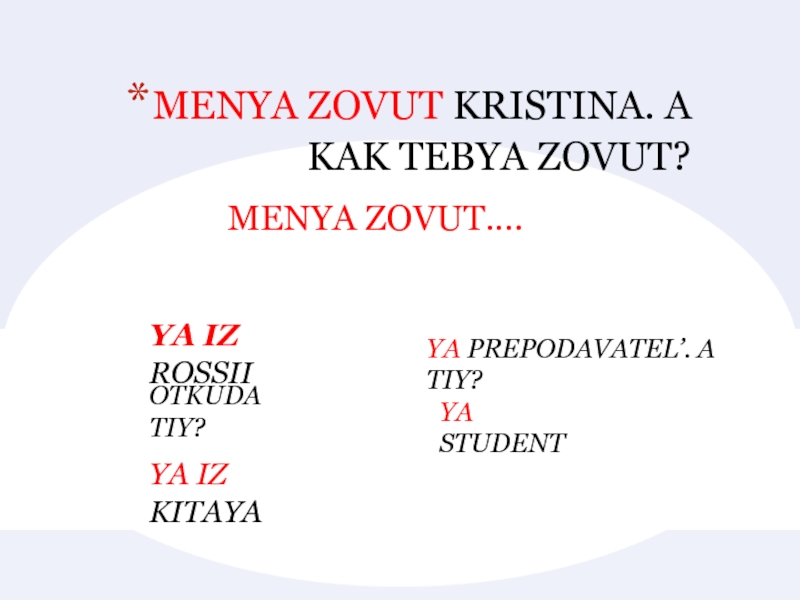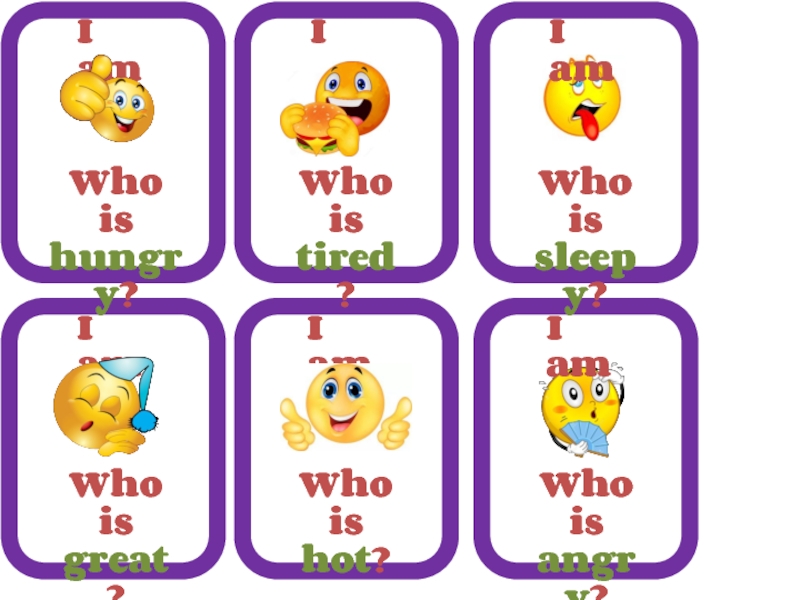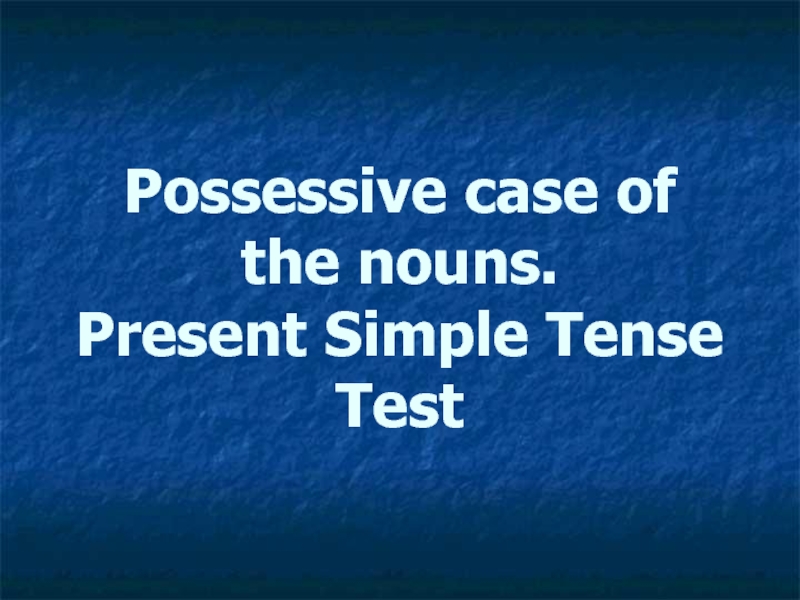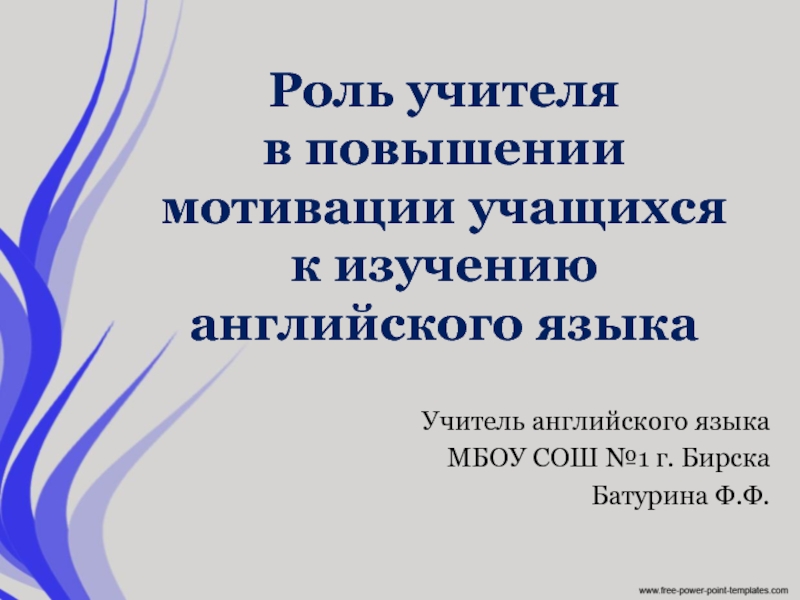- Главная
- Разное
- Дизайн
- Бизнес и предпринимательство
- Аналитика
- Образование
- Развлечения
- Красота и здоровье
- Финансы
- Государство
- Путешествия
- Спорт
- Недвижимость
- Армия
- Графика
- Культурология
- Еда и кулинария
- Лингвистика
- Английский язык
- Астрономия
- Алгебра
- Биология
- География
- Детские презентации
- Информатика
- История
- Литература
- Маркетинг
- Математика
- Медицина
- Менеджмент
- Музыка
- МХК
- Немецкий язык
- ОБЖ
- Обществознание
- Окружающий мир
- Педагогика
- Русский язык
- Технология
- Физика
- Философия
- Химия
- Шаблоны, картинки для презентаций
- Экология
- Экономика
- Юриспруденция
Contrastive Lexicology 1, Cross-Linguistic Correspondences in Translation презентация
Содержание
- 1. Contrastive Lexicology 1, Cross-Linguistic Correspondences in Translation
- 2. CROSS-LINGUISTIC CORRESPONDENCES IN TRANSLATION A lexical correspondence
- 3. CROSS-LINGUISTIC CORRESPONDENCES IN TRANSLATION: FOREIGN WORDS These
- 4. FOREIGN INSERTIONS IN ENGLISH SPEECH IN
- 5. FOREIGN WORDS IN SAMPLES OF ENGLISH SPEECH
- 6. FOREIGN WORDS IN TRANSLATION
- 7. FOREIGN WORDS: INTERTEXUALITY Being stored in the
- 8. COMMENTARIES Commentaries include factual encyclopedic information: «когда
- 9. COMMENTARIES: EXAMPLE The common (objective) meaning of
- 10. THE DEVICE OF NOTIONAL COMPENSATION To be
- 11. THE DEVICES OF TRANSLITERATION / TRANSCRIPTION AND
- 12. «ЯДЕРНЫЕ ТЕКСТЫ» «Есть корпус текстов, известных широко
- 13. THE SPECIFICATION DEVICE
- 14. ANALYSIS OF THE EXAMPLE In the English
- 15. SPECIFICATION DETAILS
- 16. ANALYSIS OF THE EXAMPLE The specification details
- 17. PERSONAL PROPER NAMES
- 18. COMMENTARIES In the above cases, the proper
- 19. GEOGRAPHICAL PROPER NAMES Names of streets, cathedrals,
- 20. THE CHOICE OF TRANSLATION VARIANT “The Quiet
Слайд 2CROSS-LINGUISTIC CORRESPONDENCES IN TRANSLATION
A lexical correspondence is defined as “a relation
We need to distinguish between ‘systemic (lexical) correspondence’, “where the mutual translation is validated by a bilingual dictionary, and ‘contextual correspondence’, i.e. translation that depends on a specific context” (Kraif, 2002: 284). These two major kinds of cross-linguistic correspondences – systemic (lexical) and contextual ones – dominate the lexical spotting in contrastive analysis and translation.
Слайд 3CROSS-LINGUISTIC CORRESPONDENCES IN TRANSLATION: FOREIGN WORDS
These are words or word-combinations in
Foreign words inserted in text and put in italics are not non-equivalent items because in many cases there are correspondences in another language, still they highlight the uniqueness of cultures and national languages. It is not a question of referring to a national backup in presenting the authentic vision of a phenomenon or alluding to a concept as it is known and apprehended in the culture of its origin.
The idea is to point to a phenomenon in its natural environment, which implies that without this reference or allusion the message will be reduced and the intended communicative effect – seriously impaired.
Слайд 4FOREIGN INSERTIONS IN ENGLISH SPEECH IN THE INTERNATIONAL CORPUS OF ENGLISH
French expressions feature most prominently in the corpus data:
- “I also picked up some tins of cassolet and choucroute royale
- That’s a cabbage thing
- Oh yes with frankfurters and sausages and things”
“Ah le pain complet oh the complete whole meal yes…”
- “Large prawns mind you
- But not as big as langoustines”
“We had a very sweet rosé the other day”
“What was interesting was the breakfast, petit déjeuner”
“All those châteaux you went to visit”
“The French call it la Manche you know”
“One more to follow when les parents return from Italy in a fortnight”
“You may even have a mental picture of the place if you remember this old song Regardez”
Слайд 5FOREIGN WORDS IN SAMPLES OF ENGLISH SPEECH
Latin: “The Latin word for
“Now nothing that I’ve said implies any sort of cultural judgement between languages any more than Latin as the lingua franca of learning in Europe”
Italian: “Mary Haggerty as Colombina the commedia del arte heroine I thought she sang beautifully”
“Buongiorno Emma, At last I put pen to paper and actually write a letter to you!!”
Spanish: “Muchas gracias for your letter which came this morning”
German: “This reaction was triggered as the result of the German Aufklarung or enlightenment movement”
Слайд 7FOREIGN WORDS: INTERTEXUALITY
Being stored in the information thesaurus, foreign words are
Such elements contribute to the effect of intertextuality which consists in the interaction of a given text with fragments or the entire range of other texts as part of philological heritage.
«Интертекстуальность – это наличие в тексте элементов, которые, вследствие целенаправленной авторской стратегии или же безотносительно его интенции, активируют в сознании читателя другие, прочитанные им ранее тексты».
(Малаховская, 2007: 5)
Слайд 8COMMENTARIES
Commentaries include factual encyclopedic information: «когда в качестве пояснения приводятся данные
Commentaries are also meant to make clear how a piece of ‘evoked’ text or a fragment of background knowledge relates to the present context.
«Исследовательский комментарий реалий, включающий в себя конкретные данные энциклопедического комментария, должен иметь характер 1) лингвострановедческий (то есть раскрывающий национальные особенности восприятия внеязыкового факта) и 2) контекстуально-ориентированный (то есть указывающий на ту роль, которую этот внеязыковой фактор играет в данном художественном произведении)»
(Тер-Минасова, 2000: 98).
Слайд 9COMMENTARIES: EXAMPLE
The common (objective) meaning of the French expression coup de
In the above instance it is interpreted within a broader context to be rendered as “смертельный удар, наносимый умирающему из сострадания.”
The shift of the semantic focus in this case is an indication of the translator’s effort not only to explain the meaning proper, but also to show its contextual role in the development of the story («контекстуально-ориентированный комментарий»).
Слайд 10THE DEVICE OF NOTIONAL COMPENSATION
To be fully grasped by speakers of
Слайд 11THE DEVICES OF TRANSLITERATION / TRANSCRIPTION AND CALQUES
When transliteration is
Transcription is realized at the level of phonemes (‘know-how’ / ‘ноу-хау’, ‘impeachment’ / ‘импичмент’)
Calques present literal word-for-word translations of compound words or collocations when morpheme components or word-like elements within their structure are replaced by their direct lexical equivalents (‘hyperlink’ / ‘гиперссылка’, ‘repertory theatre’ / ‘репертуарный театр’, ‘культурная революция’ / ‘cultural revolution’).
Слайд 12«ЯДЕРНЫЕ ТЕКСТЫ»
«Есть корпус текстов, известных широко (это универсальные тексты, т.е. тексты
(Гусева, 2009: 9)
Слайд 14ANALYSIS OF THE EXAMPLE
In the English translation we come across a
Слайд 16ANALYSIS OF THE EXAMPLE
The specification details added by the translator seem
Слайд 18COMMENTARIES
In the above cases, the proper names are made explicit in
«Жан Марк Нантье (1685-1766) – французский художник, известный своими портретами придворных дам. Голубой цвет был одним из любимых им тонов, в частности, известен его портрет «Дама в голубом».
«Речь идет о мебели, носящей имя Томаса Чиппендейла (1718-1779), известного английского мебельного мастера, автора образцов мебели в стиле рококо»
Слайд 19GEOGRAPHICAL PROPER NAMES
Names of streets, cathedrals, city boroughs, newspapers, magazines, different
This becomes indispensable when geographical proper names acquire symbolic value unknown to an average target language speaker, for example:
Fleet Street – a street in central London where newspaper offices are located;
Whitehall – a street in central London where government offices are;
Downing St. 10 – the official residence of the British Prime Minister;
Harley St. – a place in London where many fashionable doctors and surgeons live;
Mayfair – the most expensive aristocratic part of London;
Chelsea – an area in the Southwest of London known for its expensive housing, its fashionable shops, and its football team.
Слайд 20THE CHOICE OF TRANSLATION VARIANT
“The Quiet American” by Graham Greene:
“- What
There were a number of factors. The need to earn a living, a curiosity about people,
and – yes, even that, a love of Gaboriau.”
At least three ways of translation are possible in this case:
Transcription accompanied by a footnote: «Необходимость зарабатывать на хлеб, любопытство к людям, да, пожалуй, и страсть к Габорио*». In the footnote: «Габорио – французский писатель (1835-1873), автор детективных романов» .
Transcription and an embedded explanation (specification): «Необходимость зарабатывать на хлеб, любопытство к людям, да, пожалуй, и страсть к детективным романам Габорио».
Omission of the name and descriptive translation: «Необходимость зарабатывать на хлеб, любопытство к людям, да, пожалуй, и страсть к французским детективным романам».
(Перевод Е. Голышевой)
The device used in the last variant is a form of generalizing transformation (генерализация как вид трансформационного перевода). Although lately there has been a tendency to omit all kinds of footnotes and embedded explanations as they impede the flow of writing, transformations should better be avoided. With regard to semantic-pragmatic adequacy the second variant seems to be most appropriate.
